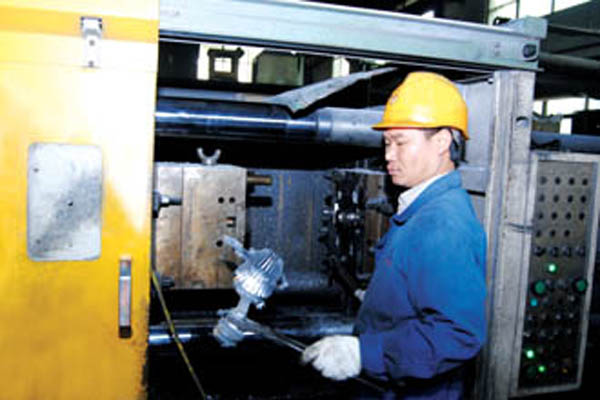A lot of quality problems may be encountered
in die casting production,
which are caused by various reasons. The quality problems in production shall
be reasonably identified. The root causes shall be found before it is possible
to put forward the corresponding feasible improvement measures, so as to
continuously improve the quality of castings.
The quality problems, defect
characteristics, causes including improvement measures in die casting are
described as follows.

A.Undercasting
In the die casting forming process, some
locations of the part are not filled completely, which is referred to as undercasting.
When the location has serious undercasting, the shape of castings can be considered
as non-conformance to the requirements of the drawings. Usually, it is allowed
to have undercasting in parts.
Causes of undercasting:
1) Poor conditions for filling; the
location of undercasting has irregular set metal
In case the pressure is insufficient,
the forefront of fluid metal solidifies prematurely, which causes angle, deep
concave, thin wall (even thinner than average wall thickness) and cylindrical
holes in the wall.
-
Low mold temperature
-
Alloy injected at low temperature
-
Poor location of injection gate, forming large
flow resistance
2) Gas blocking
results in smooth surface but irregular shape at undercasting locations
-
Gas accumulation in locations difficult to make relieving system,
-
When the molten metal is flowing, it has severe
turbulence and includes gases
3) Mold cavity
with residue
-
Inappropriate paint dosage or spraying method
cause local coating deposition
-
Large splicing clearance in molded parts or large sliding fitting clearance allows in
metal during filling. After the casting
is released, the metal is not completely taken out but forms chips in the
clearance. When such metal chips (their thickness is same as clearance) protrude
out the mold surface, and in this case, the protruding part can form the wall
thickness of casting, which cause the castings produced later to have
penetrating groove (for wall thickness). That penetrating groove is a special
form of undercasting, which is commonly seen in the deep spliced cavity.
-
Insufficient material injected (including excessively
thin surplus material section).
-
On vertical die casting machines, during injection,
the downward movement of lower punch doesn’t open the nozzle orifice wide
enough, which causes a series of poor filling conditions.
B. Crack
The base material of casting is destroyed
or disconnected to form a narrow gap in the form of irregular line. Under the
action of external forces, it has the tendency to develop. This kind of defect is
called crack. On the die casting parts, cracks are not allowed to exist.
Causes
of cracks:
1. Structure
and shape of casting
-
Abrupt transformation at connection between
thick wall and thin wall of castings
-
Insufficient trounded
corners on castings
-
Insufficient locations on castings for ejector rods, which causes uneven distribution of ejector
rods
-
Thoughtless casting design, which results in
rupture due to shrinkage stress.
2. Poor surface
quality and unstable fastening of the molded parts
-
Concave on formed surface along the direction of
mold releasing, which cause tears on casting
-
Failure to eliminate the processing traces at
the root of convex molded surface
-
The molded parts has deviation in fastening,
which impedes mold releasing.
3.Poor ejection
-
Improper placement of mold ejection components (location
or number)
-
The ejection mechanism has deviation, which
brings about unbalanced force on casting
-
Unreasonable connection between mold ejection
mechanism and hydraulic ejection device, deviated or uncoordinated.
-
Inconsistent lengths of ejection rods when the
ejection pins are ejecting, inconsistent lengths of hydraulic ejection rods.
4. Alloy composition
1) Zinc alloy
A. High contents of harmful impurities
like lead, tin and cadmium
B. Insufficient purity
2) Aluminum
alloy
A. High iron
content, acicular ferrite increased
B. High silicon
content in the aluminum silicon alloy
C. High
magnesium content in the aluminum magnesium alloy
D. High contents of other impurities
increasing brittleness
3) Magnesium
alloy
4)High contents of aluminum and silicon
5) Alloy
melting quality
A. The melting
temperature is too high, resulting in segregation
B. The heating
time is too long, resulting coarse grains
C. Too many oxide inclusions
6) Improper operation
A. Too long stay in mold, especially for
alloys of high brittleness, such as magnesium alloy
B. Improper coating quantity, resulting
in deposits
7) Poor filling, incomplete metal base
fusion, insufficient strength after setting, especially prone to locations far
from injection gate.
Know More: Die Casting China







